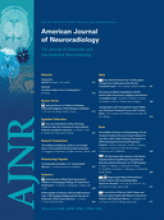Abstract
BACKGROUND AND PURPOSE: Dysfunction of DA neurotransmission from the SN and VTA has been implicated in neuropsychiatric diseases, including Parkinson disease and schizophrenia. Unfortunately, these midbrain DA structures are difficult to define on clinical MR imaging. To more precisely evaluate the anatomic architecture of the DA midbrain, we scanned healthy participants with a 7T MR imaging system. Here we contrast the performance of high-resolution T2- and T2*-weighted GRASE and FFE MR imaging scans at 7T.
MATERIALS AND METHODS: Ten healthy participants were scanned by using GRASE and FFE sequences. CNRs were calculated among the SN, VTA, and RN, and their volumes were estimated by using a segmentation algorithm.
RESULTS: Both GRASE and FFE scans revealed visible contrast between midbrain DA regions. The GRASE scan showed higher CNRs compared with the FFE scan. The T2* contrast of the FFE scan further delineated substructures and microvasculature within the midbrain SN and RN. Segmentation and volume estimation of the midbrain SN, RN, and VTA showed individual differences in the size and volume of these structures across participants.
CONCLUSIONS: Both GRASE and FFE provide sufficient CNR to evaluate the anatomy of the midbrain DA system. The FFE in particular reveals vascular details and substructure information within the midbrain regions that could be useful for examining structural changes in midbrain pathologies.
Abbreviations
- AP
- antero-posterior
- BOLD
- blood oxygen level–dependent
- CNR
- contrast-to-noise ratio
- DA
- dopamine or dopaminergic
- EPI
- echo-planar imaging
- FA
- flip angle
- FFE
- fast-field echo
- FH
- foot-head
- fMRI
- functional MR imaging
- GRASE
- gradient and spin echo
- RL
- right-left
- RN
- red nucleus
- RNdv
- red nucleus densely vascularized section
- RNpv
- red nucleus poorly vascularized section
- SENSE
- sensitivity encoding
- SN
- substantia nigra
- SNc
- substantia nigra pars compacta
- SNR
- signal-to-noise ratio
- SNr
- substantia nigra pars reticulata
- SWI
- susceptibility-weighted imaging
- VTA
- ventral tegmental area
- Copyright © American Society of Neuroradiology
Indicates open access to non-subscribers at www.ajnr.org












